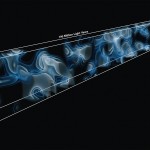W. M. Keck Observatory press release…
A team led by astronomers from the Max Planck Institute for Astronomy has created the first three-dimensional map of the ‘adolescent’ Universe, just 3 billion years after the Big Bang. This map, built from data collected from the W. M. Keck Observatory, is millions of light-years across and provides a tantalizing glimpse of large structures in the ‘cosmic web’ – the backbone of cosmic structure.

Now a team of astronomers led by Khee-Gan Lee, a post-doc at the Max Planck Institute for Astronomy, has created a map of hydrogen absorption revealing a three-dimensional section of the universe 11 billions light years away – the first time the cosmic web has been mapped at such a vast distance. Since observing to such immense distances is also looking back in time, the map reveals the early stages of cosmic structure formation when the Universe was only a quarter of its current age, during an era when the galaxies were undergoing a major ‘growth spurt’.
The map was created by using faint background galaxies as light sources, against which gas could be seen by the characteristic absorption features of hydrogen. The wavelengths of each hydrogen feature showed the presence of gas at a specific distance from us. Combining all of the measurements across the entire field of view allowed the team a tantalizing glimpse of giant filamentary structures extending across millions of light-years, and paves the way for more extensive studies that will reveal not only the structure of the cosmic web, but also details of its function – the ways that pristine gas is funneled along the web into galaxies, providing the raw material for the formation of galaxies, stars, and planets.
Using the light from faint background galaxies for this purpose had been thought impossible with current telescopes – until Lee carried out calculations that suggested otherwise. To ensure success, Lee and his colleagues obtained observing time at Keck Observatory, home of the two largest and most scientifically productive telescopes in the world.
Although bad weather limited the astronomers to observing for only 4 hours, the data they collected with the LRIS instrument was completely unprecedented. “We were pretty disappointed as the weather was terrible and we only managed to collect a few hours of good data. But judging by the data quality as it came off the telescope, it was clear to me that the experiment was going to work,” said Max Plank’s Joseph Hennawi, who was part of the observing team.
“The data were obtained using the LRIS spectrograph on the Keck I telescope,” Lee said. “With its gargantuan 10m-diameter mirror, this telescope effectively collected enough light from our targeted galaxies that are more than 15 billion times fainter than the faintest stars visible to the naked eye. Since we were measuring the dimming of blue light from these distant galaxies caused by the foreground gas, the thin atmosphere at the summit of Mauna Kea allowed more of this blue light to reach the telescope and be measured by the highly sensitive detectors of the LRIS spectrograph. The data we collected would have taken at least several times longer to obtain on any other telescope.”
Their absorption measurements using 24 faint background galaxies provided sufficient coverage of a small patch of the sky to be combined into a 3D map of the foreground cosmic web. A crucial element was the computer algorithm used to create the 3D map: due to the large amount of data, a naïve implementation of the map-making procedure would require an inordinate amount of computing time. Fortunately, team members Casey Stark and Martin White (UC Berkeley and Lawrence Berkeley National Lab) devised a new fast algorithm that could create the map within minutes. “We realized we could simplify the computations by tailoring it to this particular problem, and thus use much less memory. A calculation that previously required a supercomputer now runs on a laptop”, says Stark.
The resulting map of hydrogen absorption reveals a three-dimensional section of the universe 11 billion light years away – this is first time the cosmic web has been mapped at such a vast distance. Since observing to such immense distances is also looking back in time, the map reveals the early stages of cosmic structure formation when the Universe was only a quarter of its current age, during an era when the galaxies were undergoing a major ‘growth spurt’. The map provides a tantalizing glimpse of giant filamentary structures extending across millions of light-years, and paves the way for more extensive studies that will reveal not only the structure of the cosmic web, but also details of its function – the ways that pristine gas is funneled along the web into galaxies, providing the raw material for the formation of galaxies, stars, and planets.

